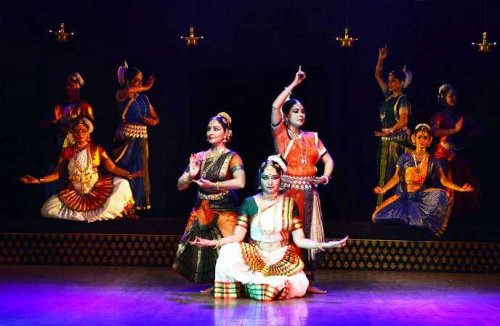
|   |

|   |
Nrityanjali 25 - Veena Murthy Vijay e-mail: veenamurthyvijay@gmail.com March 31, 2016 Poornima Ashok, Bangalore’s well known Bharatanatyam dancer celebrated ‘Nrityanjali 25,’ the silver jubilee anniversary of her institution on February 20, 2016 at ADA Rangamandira. There is a sea of change in the festivals conducted in these times. The scale and the reach have been very vibrant and growing. But with social media playing an important role, there has been a severe risk of lack of discrimination of the very scale or quality of such festivals and its performances. Nrityanjali 25 was conducted well by Poornima Ashok’s organization. The first part of the evening opened with ‘Shivothsavam,’ a traditional Pallaki Seva Prabandam revived from Shahaji Maharaja’s vast collection of compositions which are most suitable for dance productions. The thematic presentation was choreographed by Bharatanatyam exponent Poornima Gururaja, a senior disciple of Guru Narmada and the director of Kala Sindhu. Poornima presented her students in this production that showcased the style with well practiced technique. This Prabanda is in praise of Lord Thyagesha of Tiruvarur. The story narrates Parvathi’s longing for Lord Shiva after the Manmatha dahana. The narrative was well crafted with simple aesthetic appeal. All the dancers enacted their roles with wonderful grace executing right proportions of nritta and abhinaya. The neat lines in their dance with well synchronized movements added beauty to the composition. Shiva in the guise of an old man arguing over the qualities of her chosen husband (Lord Shiva) in a mirthful fashion was the highlight of the theme and Parvathy’s anger towards the disguised Shiva brought a sense of climax to the plot. The wedding scene of Lord Shiva and Parvathy was well composed with a duet of thandava and lasya. The colourful Pallaki seva which relived the tradition in an auditorium ambiance was well done.  Seetha is faced with the test of chastity through “Agniparisksha”, after Rama defeats Ravana in war and protects Seetha. She accepts the “Agnipariksha,” jumps into the blazing fire and comes out unscathed proving her purity in thought, deed and form. After they go back to Ayodhya, Rama is blamed by a simple dhobi for accepting his wife who has been abducted by another man and remaining in captivity with another man. Rama mercilessly but with great helplessness, sends a pregnant Seetha to the forest again. Seetha leaves Ayodhya and lives in the forest away from Rama and brings up her sons Lava and Kusha. When Rama meets Seetha along with their sons, he pleads with her to come back to Ayodhya. Seetha refuses to return, she tells Rama that her duty as a wife, queen and mother is over. She becomes one with her mother earth, ‘The Bhumi.’ Aruna Mohanty’s portrayal of Seetha was powerful. The strong conviction of Seetha was enacted with great involvement bringing out the karuna rasa experience in the audience. Aruna’s command over the dance form was well established in her rendition of abhinaya along with the nrittha, and the plot came alive by her internalisation of both these elements of dance. Radha, the second remarkable mythological character, was portrayed by Poornima Ashok. The unconditional love of Radha towards Krishna brought out myriad emotions layering one over the other bringing out the stages of reaching oneness with divine and self. Poornima portrayed the young Radha wanting Krishna and falling in love with him innocently with defined movements and facial expressions. The transition of Radha’s love for Krishna from innocence to a matured devotional love was beautifully enacted by making the flute as her friend in whom she confides. This dance piece of sringara bhava with lilting movements and graceful style with subtle satvika abhinaya was a wholesome treat to watch. Draupadi, the great epic Mahabaratha’s most important character, questions her friend lord Krishna (sakha) of her victory of the Kurukshetra war. Bheema fulfills his wow of destroying Dhuryodana and smearing her hair with his blood. But the price she has paid for this is losing her 5 children and all her family members. Is her victory of revenge justified? Is it the victory that she should rejoice or loss that she should mourn? These conflicting emotions were well conceptualized and rendered with great mastery of satvika abhinaya by Mohinattam dancer Gopika Varma. The sadness and victorious emotions coupled with the underlying anger and revenge were rendered with much restraint. Gopika’s rendition of Draupadi had a telling effect on the audience. All the three eminent dancers expressed their emotions with great internalization of the theme and characters they played. Though the dance styles were different in form, they had a homogenous effect of perfection to the overall flow of the theme. The strong but subtle emphasis of higher empowerment of each character bringing out the power of women was executed by all the dance exponents in masterly grandeur. The highlight of this production was their rendition of satvika abhinaya which was powerful in portraying the characters of the theme. The pushpanjali and thillana were presented as the beginning and conclusion of the theme by all the three dancers along with their respective group. This added colour and brilliance to the entire production. The whole festival was a well thought out event with meaningful presentations. Dr. Veena Murthy Vijay is the Director of Sri Raja Rajeshwari Kala Niketan, Samanvay Dance Company and AIM Bengaluru International Arts Festival. |